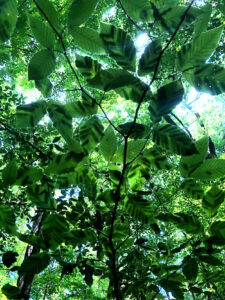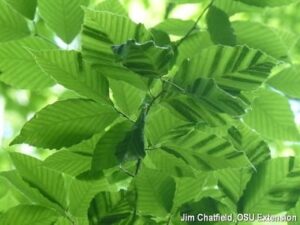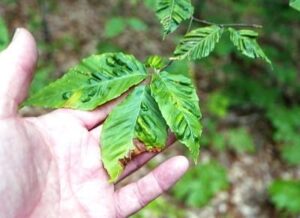
Beech tree at Creekshead Preserve. The leaves show dark, thickened stripes between veins, which is an early sign on beech leaf disease. Photo by Camryn Brent
Beech leaf disease (BLD) and the associated foliar nematode species have been confirmed at Legacy’s Creekshead Preserve located in Salem Township, Washtenaw County.
In June, Legacy was contacted by University of Michigan, School for Environment and Sustainability (SEAS) research scientist, Dr. Stella Cousins. During a visit to Creekshead Preserve she saw visual symptoms of beech leaf disease on some of the beech trees. Samples she collected were sent to Michigan Department of Rural Development (MDARD) and confirmed through genetic testing to contain a species of nematode that is closely associated with BLD.
Until now, the only known occurrences of BLD in Michigan were in Oakland, St. Clair, and Wayne Counties. The discovery of it at Creekshead is the first case in Washtenaw County confirmed through genetic testing. We have been informed that symptoms have been observed at other locations throughout Washtenaw County, and surveys are still on-going.
Unfortunately, much remains unknown about the disease and how it spreads, and there is no known treatment at this time.
“Legacy is doing all that we can at this time to better understand our next steps,” Legacy Preserve Stewardship Manager Kyler Moran said. “The health of our preserves remains our top priority and we are working diligently with local, state, and national experts as we navigate this newly discovered disease at Creekshead.”
What is beech leaf disease?
According to the United State Department of Agriculture Forest Services, beech leaf disease is a novel disease affecting American beech (Fagus grandifolia) in North America. Symptoms of BLD have also been observed on European (F. sylvatica), Oriental (F. orientalis), and Chinese (F. engleriana) beech species, which are occasionally planted as ornamentals.
Symptoms of beech leaf disease were first observed in northeast Ohio in 2012 and have since been detected in eleven midwestern and northeastern states as well as Ontario, Canada. American beech trees with symptoms were first reported in Michigan in 2022.
Although research is ongoing, beech leaf disease is closely associated with a subspecies of the anguinid nematode, Litylenchus crenatae mccannii. While the mechanisms of leaf damage are not fully understood, research indicates that this nematode is associated with buds and leaves of damaged beech of all age classes. Aborted bud development and premature leaf drop result in a thinning of canopy over time.
Several methods are being studied, however, no treatments are currently available for affected trees. Tree mortality of all age classes has been observed within 2 to 7 years but appears to be more rapid and common in smaller trees.
What is Legacy doing about it?
The disease is new to Michigan and has only been confirmed in a few counties. We are in the process of learning more about what this means for our trees, our preserve, and the surrounding community. As we gather more information through our resources at the Michigan DNR, the University of Michigan, Michigan State University Extension, JLW CISMA, and other partner organizations, we will better understand our next steps.
Dr. Cousins and her team at the University of Michigan are currently studying beech leaf disease distribution and ecological impacts.
“Beech leaf disease has spread rapidly across the range of American beech, and this year observations have been surfacing in many locations throughout southeast Michigan,” Dr. Stella Cousins said. “The mild symptoms noted so far at Creekshead may suggest that the disease is a recent arrival to this location.”
Beginning this summer, Creekshead and Shatter Preserves will be included as study sites in their larger research project. While the disease has not been confirmed at Shatter Preserve, given its close proximity to Creekshead, it will also be monitored for symptoms.
“The Preserves will be an important piece of the puzzle as we investigate beech leaf disease distribution and impacts, so we are grateful to Legacy for their cooperation–and hopeful that a better understanding of this disease will ultimately help protect beech trees and forests across the region,” Dr. Cousins said.
What can you do?
Although there is no known treatment at this time, early detection is a key part of ongoing state and federal research and will be instrumental in understanding the factors that shape BLD’s rapid spread. Detecting BLD symptoms early also helps predict how forests may change and discover potential management options.
If you have beech trees on your property, monitor them regularly and look for any signs of symptoms. If you suspect your beech trees are affected, take one or more photos and make note of the location, date and time of the observation, and report to:
- DNR Forest Health Division: [email protected] or by phone at 517-284-5895.
- Or use the Midwest Invasive Species Information Network (MISIN) online reporting tool.
- Or download the MISIN smartphone app and report from your phone – MISIN.MSU.edu/Apps/#Home.
More resources are available here:
- https://www.michigan.gov/invasives/id-report/disease/beech-leaf-disease
- https://www.clevelandmetroparks.com/parks/education/education-resources/publications
WHAT TO LOOK FOR
- Striping – bands of thickened, dark green tissue between the leaf veins.
- Distorted, puckered or curled leaves.
- Leaf symptoms that are visible from leaf out until fall, best seen by looking up into the canopy.
- Some branches may be affected while others are not.
- Reduced leaf and bud production and possible leaf loss as disease progresses.
- Dark, thickened stripes between leaf veins are early signs. Photo courtesy of Jim Chatfield, OSU Extension.
- Puckering, or raised areas between veins, may distort leaf shape. Photo courtesy of Jim Chatfield, OSU Extension.
- In late stages, beech leaf disease may cause extreme leaf distortion and curling. Photo courtesy of John Pogacnik, Ohio DNR.




 RSS Feed
RSS Feed